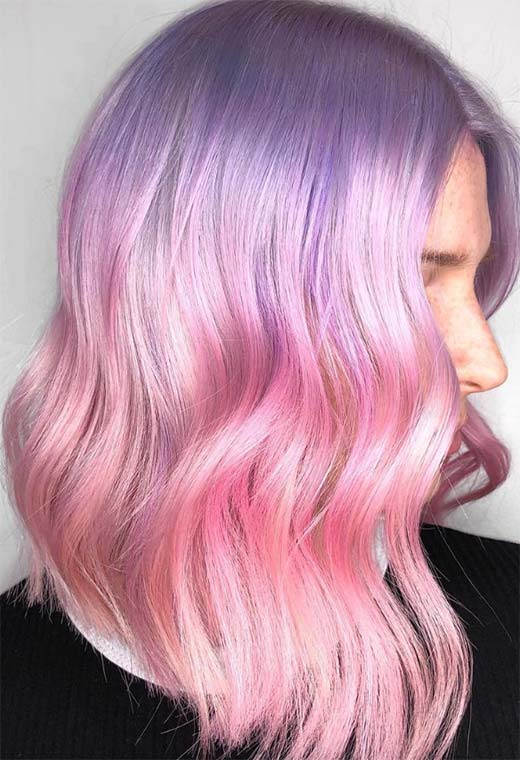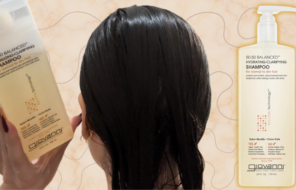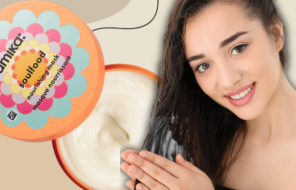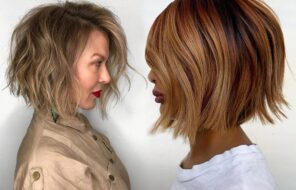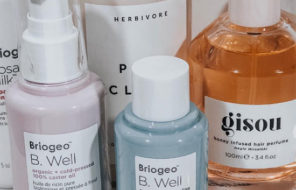Most recently, Kylie Jenner turned heads at the Met Gala with sleek lilac hair that we are sure thousands of adoring fans would like to emulate – we’ll help you do just that today.
To start, it’s important to figure out which shade of lilac hair color will work best with your skin tone. It’s also important that you dye your hair properly and safely, so I included a guide for doing so at home.
Once you’ve dyed your hair a beautiful lilac, you want to keep it vibrant, so I’ve listed some important maintenance tips. Should you change your mind, though, we’ve also included a guide on how to fade lilac hair dye. Your overall look might need some altering in order to work with lilac hair colors, so we added some makeup and fashion tips to go with your new hair.
In this article:
- Finding the Perfect Lilac Hair Color Shade for Your Skin Tone
- How to Dye Hair Lilac at Home
- Tips for Maintaining That Lovely Lilac Hair Color
- How to Remove Lilac Hair Dye
- Your Makeup Routine for Your Lilac Hair
- Building Your Wardrobe to Match Your Lilac Hair
Finding the Perfect Lilac Hair Color Shade for Your Skin Tone
Lilac hair colors are easy to wear as they tend to be quite flattering. However, it’s important to understand exactly what lilac hair is. The lilac color, named after the beautiful flower, approximates the color the flower has in nature. It is a medium-light purple tone that is usually comprised of an equal amount of blue and red undertones.
Lilac hair color is just a touch darker than a pastel, making it a great choice for those whose skin is very fair and gets washed out by pastel hair. As with any hair color, the key is to choose a shade of lilac hair that is either darker or lighter than your skin tone, since some contrast is flattering – if the skin tone and hair color are of the same strength then you will end up looking washed out.
Lilac Hair for Cool Skin
Those with cool skin usually have veins that appear purplish, with pinkish undertones to their skin. If this is your skin tone and you are quite fair, then any shade of lilac hair should suit you quite well! Your skin will seem clearer and more even next to lilac hair colors, since they have an incredible way of minimizing redness or blotchiness.
If your skin is a little darker, however, or if you have a tan, then you might find that your skin looks a little orange-based, in which case lilac hair colors don’t really work, as they tend to emphasize the orange undertones in an unflattering way.
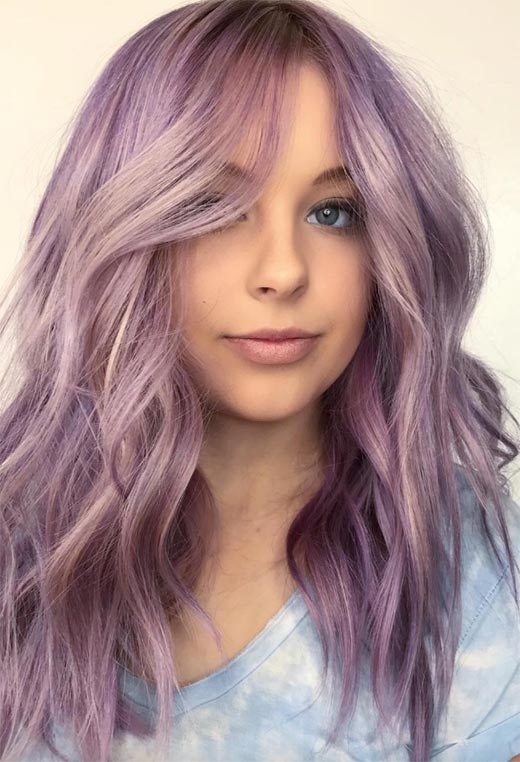
Lilac Hair for Neutral Skin
If your veins appear blue through your skin, and your overall coloring is best described as “beige” then you have neutral skin. Neutral skin looks good with any hair color, lilac hair included! You can play around with undertones, choosing lilacs that are a touch more red or a touch more blue to your heart’s content.
Lilac Hair for Warm Skin
If your veins appear greenish through your skin and you have a lot of gold or yellow to your skin then you have a warm undertone. Those with warm undertones need to be a little careful when choosing the right shade of lilac hair color, as some shades look awesome while others bring out sallowness or orangeness in the skin.
If you’re considering lilac hair then first make sure to avoid any makeup products that will make your skin pull orange, like bronzers and contour shades with orange undertones.
Overall, it is best to choose either lilac hair colors that lean a little towards more red than blue, or to opt for a balayage where the strands around your face are dyed some sort of warm shade. There are all kinds of gorgeous examples of lilac hair colors combined with warm hair colors at the end of the article!
Lilac Hair for Olive Skin
Pulling off lilac hair, as well as other shades of purple, is toughest for those with olive undertones to their skin. Olive skin has a slight greenish tint, with veins that appear very green through the skin.
This is because green and purple are opposites on the color wheel, so they end up bringing each other out. Either skip lilac hair dye altogether or consider wearing it as an accent, making sure that the color that frames your face is a more flattering one.
How to Dye Hair Lilac at Home
While lilac hair dye might not be considered a pastel, it is still a light fashion hair color. If you want to dye your hair a lilac that will look vivid then chances are you will have to bleach your hair first, unless you have naturally very light blonde hair.
We’ll give you suggestions on bleaching your hair at home, but it’s important to reinforce the fact that bleaching the hair will damage it no matter what. A professional colorist will have years of experience and all kinds of tools in their arsenal that can help prevent excessive damage.
It’ll be much harder to bleach the hair at home as a newbie. Even if you’re dead set on dyeing your hair lilac by yourself, we would still recommend going to the salon at least for the bleaching.
As always, the directions are for dyeing your whole head a lilac hair color, but if you’d like you can also attempt to dye it in a different way. You can try a lilac ombre, lilac balayage, or just a few lilac streaks. The tools required and the steps would be the same, but you would need to apply the bleach and then the dye in a different way.
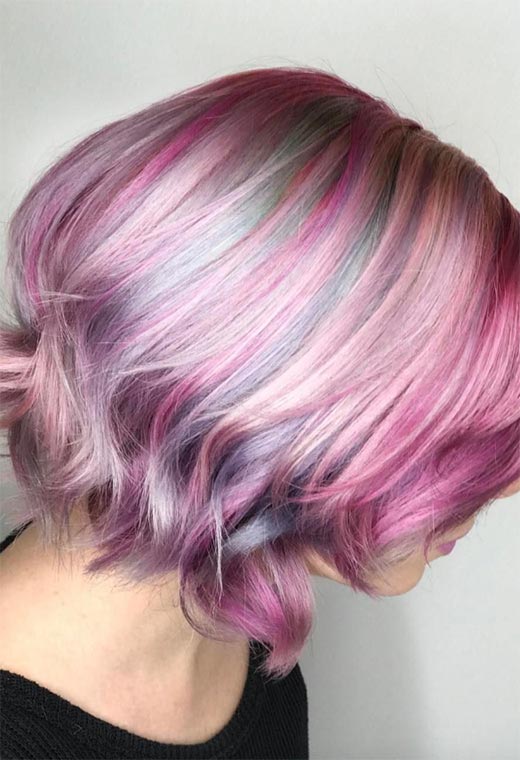
Before You Start:
- Read all of the instructions and look at the inspiration photos to make sure you have your action plan in place! You need to know exactly what you’ll be doing and how you’ll be dyeing your hair before you start.
- Consider doing a strand test a day or two before you take the plunge completely, applying bleach and then dye on a small strand of hair that’s near the back of your head. This will allow you to determine how much effort it’ll take to bleach your hair to the right level of lightness and it’ll also allow you to make sure you choose the right lilac hair dye. It will also be an opportunity to check that you’re not allergic to anything!
- Prep your color! You can use straight semi-permanent hair dye or more vivid lilac hair colors, but if you would like the color to be a little softer and more pastel then you’ll want to dilute the dye with hair conditioner or a dye fader. You might also want to shift the color a little bit if you purchased a purple hair dye. You can do so by blending in a bit of pink to make it more lilac, a bit of red to make it warmer, or a bit of blue to make it a little cooler. Patch testing your mixture will help you determine if you got it right.
- Avoid shampooing your hair for a day or two before it’s time to bleach. This will allow the lilac hair color to take better hold and will help keep your hair strong. You can still condition or mask your hair before bleaching.
You Will Need:
- Bleach kit – I recommend the Good Dye Young Lightening kit from Sephora, as it includes a 25-volume developer that is much kinder to the hair than a lot of other, more extreme bleach kits.
- Hair dye – might as well stick to the same brand! The Good Dye Young semi-permanent hair dyes from Sephora are beautiful. To get a more pastel tone you can sheer any of them out with the Fader or use a hair conditioner.
- Plastic gloves
- Plastic hair clips
- Shower cap
- Mixing bowl (non-metal)
- Dyeing brush with a pointy end
- Old zip-up or button-up shirt
- Petroleum jelly or barrier cream
- Sulfate-free shampoo
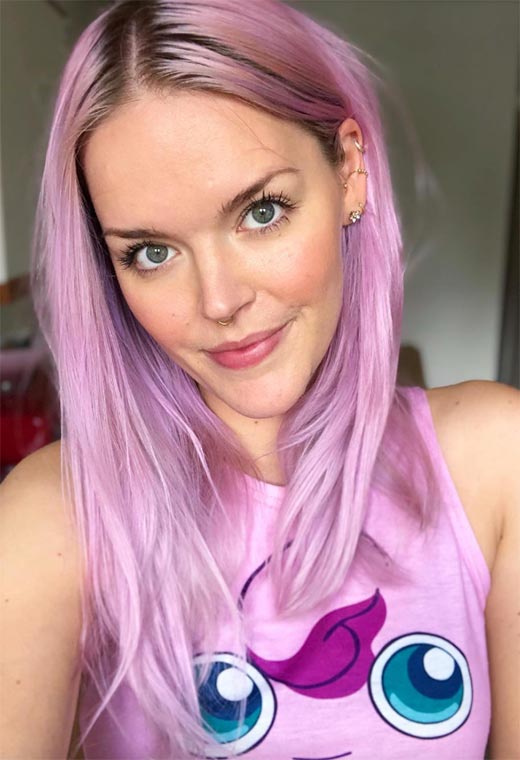
Step 1: Bleaching
- Start off by putting on an old shirt and plastic gloves and make sure your hair is dry.
- With the pointy end of your hair dye brush, part your hair into sections and then clip up those sections. I usually recommend clipping the hair into four sections by parting the hair at the crown and at the center, but if your hair is very fine, then two or three sections might be enough, while if it’s very thick you might need 5 or 6 sections.
- Line the perimeter of your hair with barrier cream or bleach in order to protect your skin.
- Prepare your bleach mixture by combining the powder with developer in your non-metal bowl and mixing them together with the hair dye brush.
- Take the clips out from the section of hair you want to start with and then sub-part it by pulling from it an even smaller section of hair.
- Dip your brush into the mixing bowl and use it to start applying the bleach about half an inch or more away from your roots. Brush it all the way down to the roots and then go over the section ensuring every strand is completely covered from all sides in bleach.
- Grab the next subsection of hair and apply the bleach in the same way. Continue in the same manner until the entire section of hair (except for the roots) is covered in bleach and then clip it back up.
- Unclip the next section of hair and cover it in bleach in the same manner. Once it’s done, clip it back up and move on to the next section, until your whole head is covered in bleach.
- You can now go back in and bleach your roots or you can leave them alone to keep them and your scalp healthy and to ensure that you can have an easier grow-out.
- Put on a shower cap and wait for the bleach to take hold and lighten your hair.
- Check under the shower cap every 10 minutes or so to see if you’re happy with the lightness level of your hair.
- After your hair has reached the correct level of lightness or after 50 minutes have passed (whichever comes first), take off the shower cap and hair clips and hop in the shower to rinse out the bleach. This is when you’ll be happy that you wore a button-up shirt!
- Rinse out as much of the bleach as you can with just lukewarm water and then condition your hair with a sulfate-free shampoo.
- Get out of the shower and let your hair gently air-dry. Examine it to make sure you’ve reached the correct level of lightness. If your hair isn’t light enough, wait at least 24 hours before doing a second bleaching session.
Step 2: Using Lilac Hair Dye
- If your hair reached the correct level of lightness, then you can immediately apply your semi-permanent lilac hair dye, which will also act as a conditioner and will help strengthen your hair by imbuing it with pigment.
- If you’re combining a few different products to make your own lilac hair dye, you can do it in the same mixing bowl you used for the bleach – just make sure to thoroughly clean it of bleach first. Alternatively, you can just dip your clean mixing brush straight into the container the lilac hair dye comes in.
- Like you did for the bleach, section your hair off and clip it up.
- Release the first section and separate from it a smaller subsection of hair.
- With the brush, apply the lilac hair dye starting at the roots and pulling it all the way down to the ends. Even if you hadn’t bleached your roots you still want to cover them in dye, as this will ensure a more seamless transition.
- Massage the dye into the hair, making sure it coats every strand thoroughly.
- Continue on to the next subsection, basically doing the same thing until the entire section of hair is thoroughly covered in lilac hair dye.
- Clip the hair back up and move on to the next section, repeating the same dyeing procedure.
- Once your whole head is covered in lilac hair dye, pull the shower cap over it and let it process.
- After 20-30 minutes remove the cap and clips, and hop in the shower. Rinse away the color with lukewarm water. There will be no need to condition the hair since the dye itself acts as a hair conditioner, and definitely avoid using shampoo for the next few days.
- Get out of the shower and gently towel-dry your hair by pressing the towel against your hair, without rubbing. Once it’s dry examine it and make sure everything looks good and even. Do any touch-ups if necessary, but if not, enjoy your new look!
Tips for Maintaining That Lovely Lilac Hair Color
- Try to avoid shampooing your hair. Even the gentlest shampoos contain detergents that will speed up the fading of your lilac hair dye. Shampooing two or three times a week should suffice!
- Make the switch to a color-safe shampoo that is sulfate-free, as sulfates are extremely strong detergents that fade color the quickest.
- A purple shampoo will help keep your color looking fresh. We recommend the Amika Bust Your Brass Shampoo from Sephora.
- Avoid overly hot water when showering, as heat will open up the hair cuticle, allowing your lilac hair color to bleed out. Instead make the switch to lukewarm or even cool water. As a bonus, this will also be way healthier for your skin!
- Keep your hair nourished by using a great leave-in conditioner that will load your hair up with moisture and proteins. This is particularly important because bleaching weakens the hair by removing proteins from it. The Olaplex Conditioner, available at Sephora, will probably have the best strengthening effect on your hair, since it helps support protein bonds. You can even add a few drops of your lilac hair dye to it every once in a while to load your hair up with more color.
- Going a few days between shampooing can be tough if you have an oily scalp. In order to keep your hair looking clean and neat in between washes use a dry shampoo to absorb oils.
- In addition to avoiding hot showers, you should also avoid heat-styling as it can damage your hair. Blow-drying your hair every once in a while on low heat and with a diffuser is okay, but straightening or curling your hair should be avoided as much as possible.
- If you do find that you have to heat-style your hair, apply a heat protecting spray first in order to mitigate some of the damage.
- The sun is a known to make hair colors fade. Wear a hat if going out in the sun, or use some sort of UV-protective hair product.
- Chlorine is another lilac hair color fader. If you are a regular swimmer, it’s better to go to a salt water pool, or just make sure to wear a swimming cap before hopping in the water.

How to Remove Lilac Hair Dye
Maybe you love changing your hair color often or perhaps you realized that lilac hair color doesn’t actually suit you. No matter the reason, here is the best course of action for removing lilac hair dye from your hair! I recommend trying these methods in the order they are listed in, as they are listed in the order of the least damaging to the most damaging, so it’s better to start off gently.
Method 1: Shampoo A Lot
A clarifying shampoo will help the lilac hair dye bleed out from your hair. Shampooing your hair with this kind of shampoo a few days in a row might be all it takes to pull enough lilac hair dye out of your hair so that you can dye it again a brand-new color.
You can choose a dedicated clarifying shampoo, a dandruff shampoo, or just any cheap, sulfate-based shampoo. Washing the hair with hot water will further help open up the hair cuticle, ensuring that the lilac hair dye bleeds out. Make sure to condition your hair very well afterwards, as all of these shampoos are extremely drying.
Method 2: Vitamin C Treatment
The vitamin C method is a little bit stronger than using a clarifying shampoo, but it’s not anywhere near as damaging as bleaching the hair. You can do it a few times in a row in order to really fade the lilac hair dye.
This method requires clarifying shampoo and vitamin C powder, which you can buy as is, or you can buy vitamin C pills (uncoated) and crush them up in a blender or with a mortar and pestle. Your hair dye brush and mixing bowl will also come in handy here.
- Make a half and half mixture of vitamin C powder and shampoo in your mixing bowl. Add a touch of water if you’d like it to be runnier. Make a large enough batch so you can cover your whole head!
- Dampen your hair a little bit to get it ready for the treatment. If you have a lot of hair, you can even section it off.
- With your hair dye brush, apply the vitamin C mixture to your lilac hair from roots to ends – this is almost the exact same process as the hair dyeing process!
- Once your whole head is covered in the mixture, pull it back or clip it up and cover it in a shower cap.
- If you want you can use a blow dryer to help open up the hair cuticles further and ensure more color comes out.
- Wait about 45 minutes, and then hop in the shower to rinse out the mixture.
- Once all the mixture is gone, use hair conditioner or a leave-in hair treatment to restore some moisture into your hair.
- Check to see how much of the lilac hair dye faded – if it’s not enough, you can repeat this method the following day. You can even do it for a few days in a row!
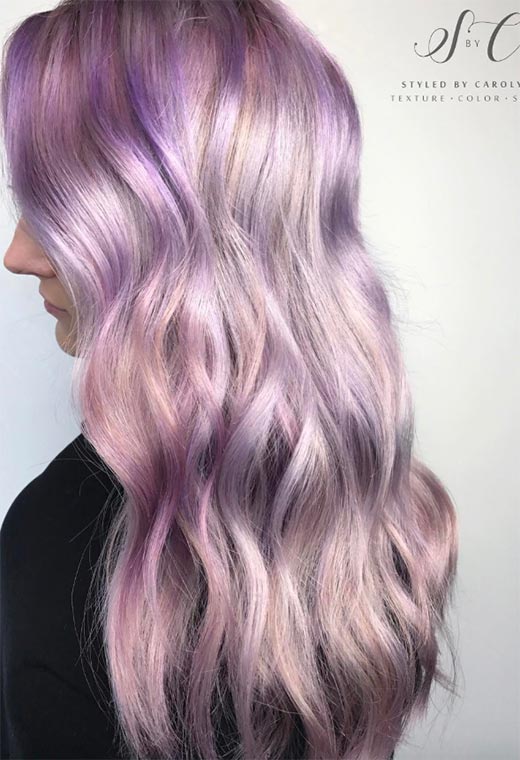
Method 3: Bleach or Color Remover
If the lilac hair dye is particularly stubborn, you can try bleaching your hair again. You will want to bleach your hair the exact same way you did when you first dyed your hair lilac, but using a weaker 10-volume developer in order to avoid damaging your hair.
The other option is two use a dedicated hair dye remover, as these are often gentler than using bleach and might even be totally bleach-free. You can try Color Oops from Ulta, for example.
Method 4: Go Darker
If you are hoping to go from lilac to a darker hair color, then just dyeing it darker might be the easiest thing to do! You still want to fade some of the more vibrant lilac tones out either by shampooing regularly or by doing the vitamin C treatment.
Keep in mind that a bit of the lilac hair color undertones might still show underneath some darker hair dyes, so it’s important to remember a bit of color theory when choosing your next color. If you’re hoping for a dirty blonde or medium brown, opt for a color that is a little bit warmer and more golden, as otherwise you risk the final result looking muddy or greenish. If you want to go for a dark brown then choose a dark brown with a slight auburn tint.
Your Makeup Routine for Your Lilac Hair
If you really enjoy your new lilac hair color, you still want to make some changes in your makeup routine to make your look more harmonious and beautiful.
Complexion Makeup for Lilac Hair
Lilac hair is quite forgiving for the complexion, and as such, you should simply wear your foundation as you normally would. Whatever kind of coverage you like will work well with your new hair color.
The same applies for highlighting and contouring – if you’re a fan, go for it, and if it wasn’t already part of your beauty look then skip it.
This assumes, of course, that you chose one of the lilac hair colors that are flattering to your skin tone. If the lilac hair color is too similar in darkness level to your skin, then you might find yourself having to counter that with the help of blush, contour or bronzer.
Speaking of blush, there are a few directions in which you could go. If you’d rather keep things simple, wear a blush that is neutral with more of a rose or berry undertone or a cool blush that is more pink, magenta, or even plum. If you really love playing with color and taking risks, however, you can try a warm-toned blush.
The key in this instance is for only the blush to contrast against your hair and for the effect to look purposeful. If your skin is already warm or if you have some orange tones in your skin, the result might not be great.
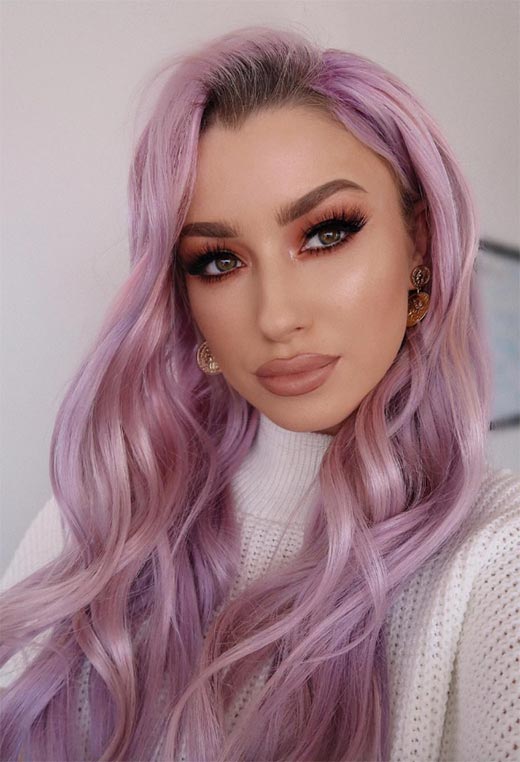
Eye Makeup for Lilac Hair
Lilac hair lends itself to so many lovely eye makeup looks. Curling the hair and pairing it with sharply winged eyeliner is a great little retro-futuristic look, while wearing it straight with a smokey eye can be very striking.
As always, sticking to the neutrals is always the easiest. If you like matte, nude looks, then beiges, browns, and taupes are the perfect eyeshadow colors, while if you prefer the drama of metallics and glitters then champagne, bronze, and gunmetal can be extremely fetching.
You can wear colors in the same family as your lilac hair, like mauve, berry, purple, magenta and lavender for a soft monochromatic look.
Once you start choosing other colors from the color wheel, you ought to remember that the lilac in your hair is going to be part of the color scheme, as will the color of your eyes, your lipstick and blush, and your outfit. You can wear all of the colors in the color wheel (orange-based colors like copper and rose gold included), but just make sure you’re working with a coherent color scheme.
Brow Makeup for Lilac Hair
Every time you change your hair color you will probably also have to change the color you use to fill in your eyebrows, and this also applies to lilac hair. Complementary undertones are very important when you have such a unique hair color.
While you definitely don’t need to start coloring your eyebrows lilac, making sure your brow pencil or pomade isn’t too yellow or red-based is very important. Instead, you want a taupey brow product that has a grayish tint and more of a blue-based undertone.
If you like keeping things soft and natural when filling in your brows then Benefit’s Gimme Brow+ Volumizing Eyebrow Gel from Sephora should do the trick – if you prefer lighter brows then choose number 1, while if you need a darker brow then choose number 5.
If you like a more defined look with a pencil, the Anastasia Beverly Hills Brow Wiz pencils in Taupe, Medium Brown, or Granite should work.

Lipstick Colors for Lilac Hair
Much like when choosing a blush, the easiest lipsticks to wear with lilac hair colors are ones that have a cool or neutral undertone. Berry and magenta lips can be very striking, while soft roses or taupey nude lips will be easy neutrals. When it comes to red lips, a blue-based red is a must for that ultra-sexy, glamorous look.
Warm red lipstick, as well as any other orange-based lipstick (i.e. coral, peach, and brick red), will definitely create a noticeable contrast against your lilac hair in a way that will work if the rest of your makeup and your outfit are very neutral, but will be very difficult to pull off otherwise.
Lastly, if you have a darker flare you can definitely try a dark lipstick! Once again, it’s better to stick to cool and neutral tones, so burgundy, deep purple, and even indigo would work best.
Building Your Wardrobe to Match Your Lilac Hair
- Because lilac hair is so cool-toned, it’s always easier to wear cool colors with it. The various shades of blue always look good with lilac hair.
- Take your inspiration from Kylie Jenner at the Met Gala and wear a monochromatic look with lilac clothes that are slightly lighter than your hair.
- If you don’t want to have to change your wardrobe from color to color, keeping things neutral is always the simplest.
- For an edgier neutral look, stick to wearing all black, which will allow your lilac hair to look super vivid.
- If you prefer something softer, beiges and white outfits are very stylish these days and they will allow your lilac hair to shine without it looking too intense.
- Wearing saturated colors with lilac hair like red, orange or green can be a little overwhelming, but pastel versions of these colors almost always look nice.
- If you really love those bright solid colors, however, then try color blocking them. Orange and lilac will only work if you also throw in a teal, for example.
- Yellow is the one brighter color that actually creates a really beautiful contrast when combined with lilac hair!
- Analog looks are often the most interesting, so try a look with pink and indigo, and your lilac hair will complete the color pattern.

Photos via @glam.by.heather, Instagram

